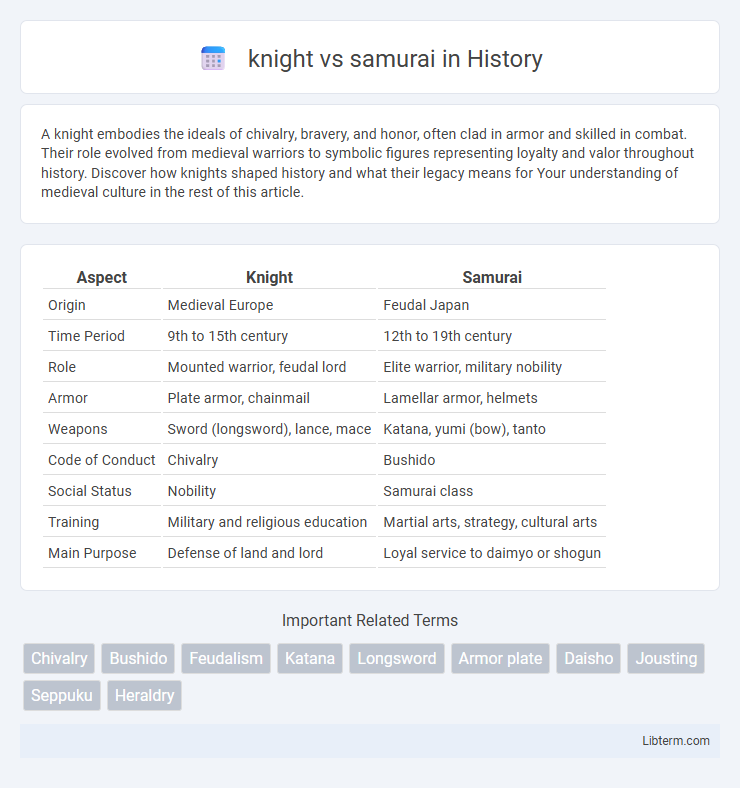A knight embodies the ideals of chivalry, bravery, and honor, often clad in armor and skilled in combat. Their role evolved from medieval warriors to symbolic figures representing loyalty and valor throughout history. Discover how knights shaped history and what their legacy means for Your understanding of medieval culture in the rest of this article.
Table of Comparison
| Aspect | Knight | Samurai |
|---|---|---|
| Origin | Medieval Europe | Feudal Japan |
| Time Period | 9th to 15th century | 12th to 19th century |
| Role | Mounted warrior, feudal lord | Elite warrior, military nobility |
| Armor | Plate armor, chainmail | Lamellar armor, helmets |
| Weapons | Sword (longsword), lance, mace | Katana, yumi (bow), tanto |
| Code of Conduct | Chivalry | Bushido |
| Social Status | Nobility | Samurai class |
| Training | Military and religious education | Martial arts, strategy, cultural arts |
| Main Purpose | Defense of land and lord | Loyal service to daimyo or shogun |
Origins and Historical Background
Knights emerged in medieval Europe between the 9th and 15th centuries as heavily armored cavalry serving feudal lords under the chivalric code, with roots tracing back to the Frankish cavalry traditions. Samurai originated in feudal Japan during the Heian period (794-1185), evolving as a warrior class loyal to regional daimyo and adhering to the bushido code emphasizing honor and discipline. Both warriors shaped their societies' military and cultural landscapes, reflecting distinct social structures and historical developments in Europe and Japan.
Social Status and Roles
Knights held a high social status within feudal European society, serving as armored warriors bound by chivalry to protect their lords and maintain order. Samurai occupied a prestigious class in feudal Japan, adhering to Bushido code, balancing martial prowess with administrative duties and loyalty to their daimyo. Both classes acted as military elites but differed in their societal roles, with knights often managing lands and samurai serving as both warriors and bureaucrats.
Code of Honor: Chivalry vs. Bushido
Knights adhered to the Code of Chivalry, emphasizing bravery, honor, loyalty, and protection of the weak, deeply rooted in Christian values and medieval European courts. Samurai followed Bushido, a strict code valuing loyalty, martial skill, honor unto death, and self-discipline, influenced by Zen Buddhism and Confucian ethics. Both codes shaped their warrior cultures by defining ethical conduct, social responsibility, and personal valor in their respective societies.
Armor and Protective Gear Comparison
Knights wore heavy plate armor made of steel, designed to provide full-body protection including helmets, gauntlets, and greaves, enabling them to withstand powerful blows and sword strikes. Samurai armor, known as O-yoroi or Tosei-gusoku, utilized layered lacquered leather and iron plates bound by silk cords, prioritizing mobility and flexibility while offering effective defense against arrows and slashes. The knight's armor was heavier and more rigid, ideal for mounted combat and close-quarter battles, whereas samurai armor balanced protection and agility suitable for versatile combat scenarios.
Weaponry and Combat Styles
Knights wielded weapons like longswords, lances, and maces, emphasizing heavy armor and shield use for close-quarter combat and cavalry charges. Samurai specialized in katana swords, yumi bows, and yari spears, focusing on precision, agility, and martial arts techniques such as kenjutsu and kyudo. Their combat styles reflect cultural priorities: knights favored armored, heavy strikes and discipline formation, while samurai mastered swift, versatile strikes with a combination of swordsmanship and archery skills.
Training and Education
Knights underwent rigorous training from a young age, starting as pages and squires learning combat skills, horsemanship, and chivalry, often within a noble household or lord's estate. Samurai training emphasized mastery of martial arts, archery, swordsmanship, and strategy, deeply rooted in Bushido principles and often included education in literature, calligraphy, and philosophy. Both warriors dedicated years to disciplined practice and mental development, but samurai education integrated cultural refinement alongside martial prowess more extensively than the knightly code.
Tactics and Battlefield Strategies
Knights employed heavy cavalry charges with tightly organized formations, relying on shock impact and armored protection to break enemy lines. Samurai utilized flexible, rapid maneuvers emphasizing archery, swordsmanship, and horseback skill, often blending individual duels with coordinated group tactics. Terrain awareness and psychological warfare played critical roles in both, but knights favored direct confrontations while samurai adapted to varied battlefield conditions with guerrilla-style tactics.
Notable Knights and Famous Samurai
Notable knights such as Richard the Lionheart and Sir William Marshal exemplify the chivalric code and military prowess of medieval Europe, renowned for their leadership in the Crusades and knightly tournaments. Famous samurai like Miyamoto Musashi and Oda Nobunaga symbolize the Bushido ethos and strategic brilliance, with Musashi celebrated for his undefeated swordsmanship and Nobunaga for unifying much of Japan during the Sengoku period. These iconic figures represent the pinnacle of martial skill and cultural values in their respective warrior traditions.
Cultural Impact and Legacy
Knights symbolize medieval European chivalry, influencing Western literature, heraldry, and notions of honor and knighthood that persist in modern cultural and historical narratives. Samurai embody the bushido code, shaping Japanese values of loyalty, discipline, and martial skill, which continue to impact contemporary Japanese art, cinema, and social identity. Both warrior classes left profound legacies that define national identities, inspire popular media, and influence global perceptions of honor and combat.
Knight vs. Samurai: Who Would Win?
Knights, armored European warriors trained in heavy cavalry tactics, relied on long swords, lances, and shields, emphasizing brute strength and defense. Samurai, elite Japanese warriors skilled in swordsmanship, archery, and swift tactics, favored the katana and agility, blending martial arts with strategic warfare. In a hypothetical matchup, the outcome depends on factors like combat environment, weapon reach, and armor effectiveness, making it impossible to definitively declare a winner.
knight Infographic

 libterm.com
libterm.com